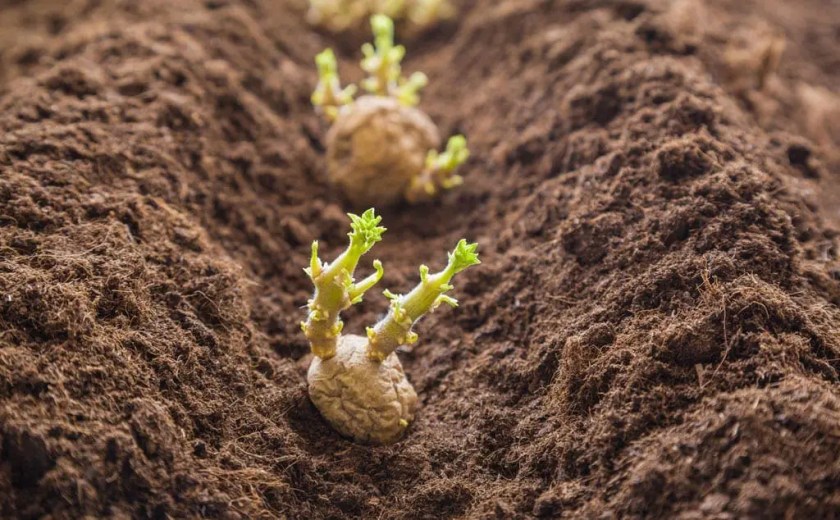Potatoes are one of our staple foods and a familiar veg to all. There is always a great supply of relatively cheap potatoes in our supermarkets all year round, so why grow your own?
Well it would be denying one of the greatest pleasures of growing your own vegetables and that is lifting your first early spuds. Nothing beats that taste of your first home-grown potatoes boiled with a sprig of mint and served with a knob of butter.
Anyone can experience this taste sensation even if they don’t have a garden. There are lots of special containers available now in which you can grow two or three potatoes, including special bags or potato barrels. Place one outside your door and enjoy a crop of home-grown new potatoes.
Enjoy more Kitchen Garden reading in the monthly magazine.
Click here to subscribe & save.
Varieties
First Earlies
- ‘Arran Pilot’
A very popular early potato with a fantastic ‘new’ potato flavour. - ‘Epicure’
A good white potato with creamy flesh. Best one to recover if touched by frost.
Second earlies
- ‘Estima’
Produces heavy crops. Good for baking potatoes and drought resistant. - ‘British Queen’
More than 100 years old, this variety produces good harvests of floury potatoes that have a delicious flavour. - ‘Desiree’
Probably the most popular red variety. Great all rounder and heavy cropping. - ‘Sante’
A good potato for pest and disease resistance. - ‘Smile’
Aptly named as this red potato has white ‘smile’ shaped markings. Great flavour as bred from red ‘Duke of York’.
Late maincrop
- ‘Pink Fir Apple’
A red knobbly shaped salad potato renowned for its delicious flavour. The shape makes them trickier to peel but the flavour outweighs this inconvenience.

Sowing & Growing Potatoes
Potatoes are tubers – storage organs produced up the base of the stems. Disease-free seed tubers are planted in spring and shoots and new roots form from these. By early to midsummer, depending on the variety, they can be lifted and the new tubers that have formed are harvested.
There are lots of varieties to choose from and they are divided into first earlies, second earlies, early maincrop and late maincrop. Seed potatoes are usually available in garden centres from about January and they can then be chitted. This means placing the tubers in a tray with the ‘eyes’ (buds on the tuber) facing upwards.
The trays are placed in a light, frost-free spot such as near a window in a shed or garage. The buds grow giving the potato a head start before planting out. Plant potatoes about 13cm (5in) deep and 30cm (12in) apart with the chitted shoots facing upwards.
Maincrop potatoes tend to be in the ground longer and produce larger plants so plant these about 38cm (15in) apart. Rows should be about 60cm (24in) apart for earlies and 76cm (30in) apart for maincrop varieties.
Once the potatoes’ leaves appear above the soil surface, cover them with some soil. This has two purposes. It protects the leaves from frost and it also helps elongate the stems which will encourage more roots and tubers to form. This process is called earthing-up and is best done two or three times as the plants grow through.
If potatoes do get frosted they often turn black. Sometimes they will grow through this damage, but it is best to avoid them getting frosted in the first place.
Growing on potatoes
When the plants start to produce flower buds, it is most important they are given adequate moisture because the tubers will be small and starting to swell. Drought at this time will result in very small tubers.
When the plants are flowering scrape away a little soil to see if the tubers are large enough to lift. New potatoes should be harvested quite small, about the size of a hen’s egg.
Scrumptious recipes for your homegrown potatoes
More on potatoes
More grow guides
 Enjoy more Kitchen Garden reading in the monthly magazine. Click here to subscribe.
Enjoy more Kitchen Garden reading in the monthly magazine. Click here to subscribe.
Sign-up to the Kitchen Garden Magazine Newsletter
Enter your e-mail address below to see a free digital back issue of Kitchen Garden Magazine and get regular updates straight to your inbox…
You can unsubscribe at any time.
About the Author
- The Joy of Growing Your Own Carrots - 22nd March 2024
- The 10 easy things you can do for success sowing in containers - 29th February 2024
- How to grow your own plant-based protein this Veganuary - 8th January 2024









